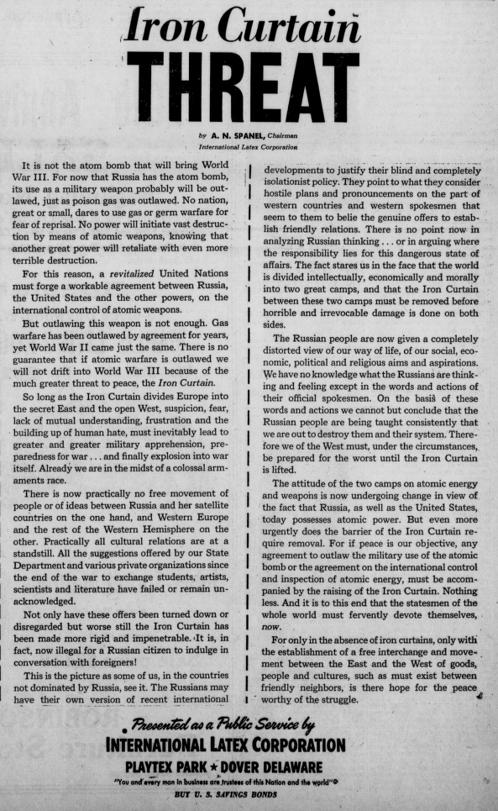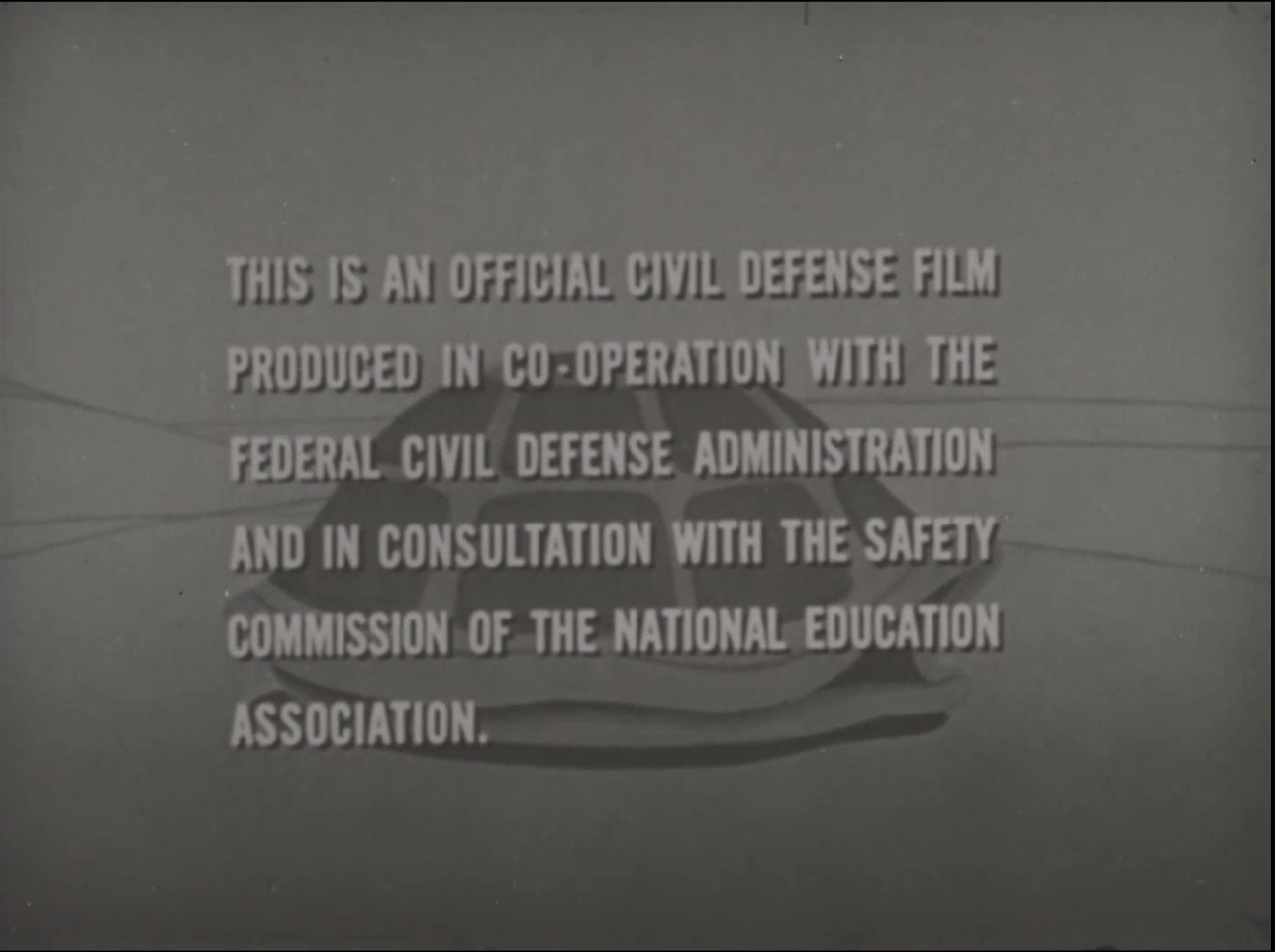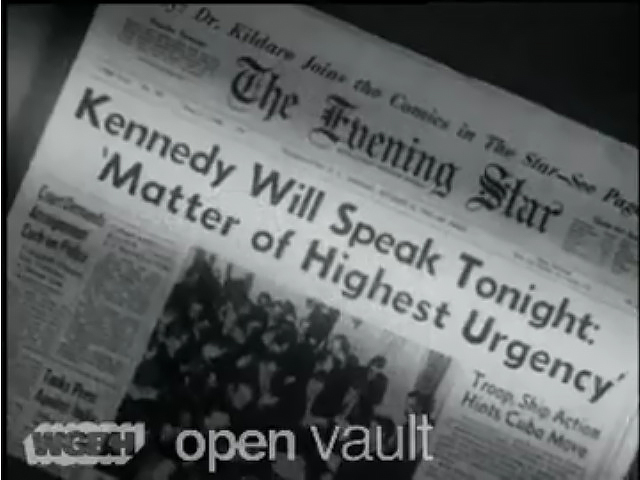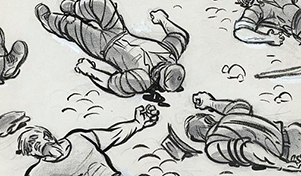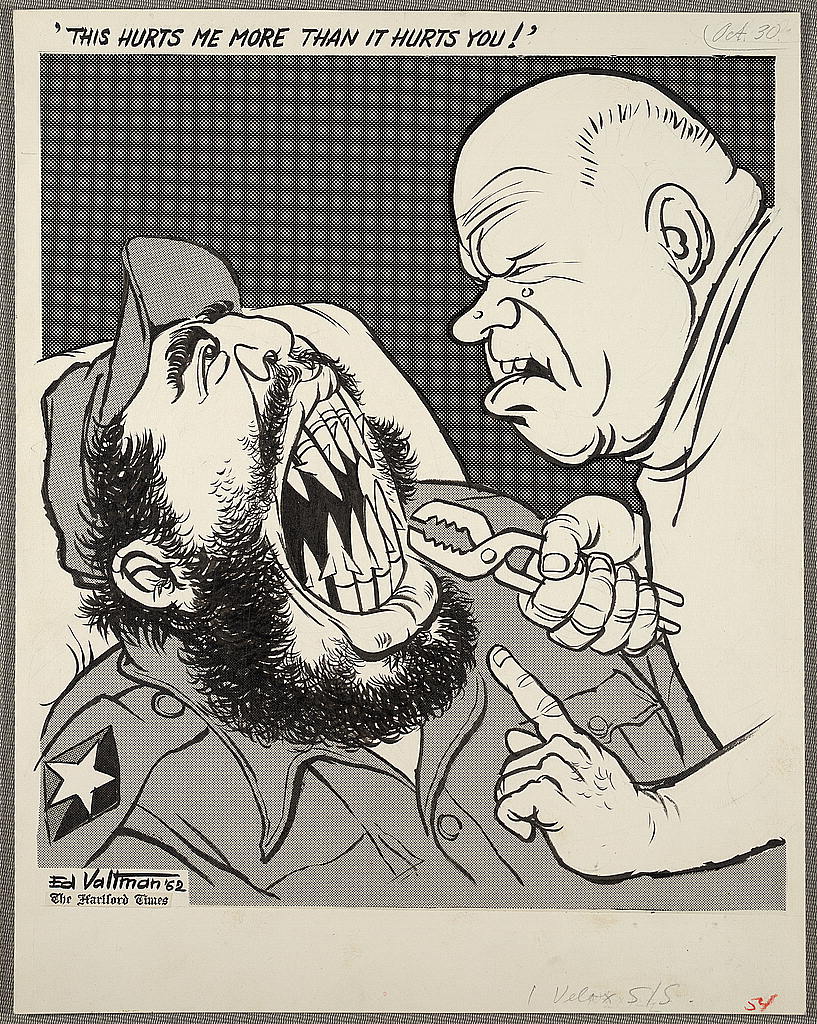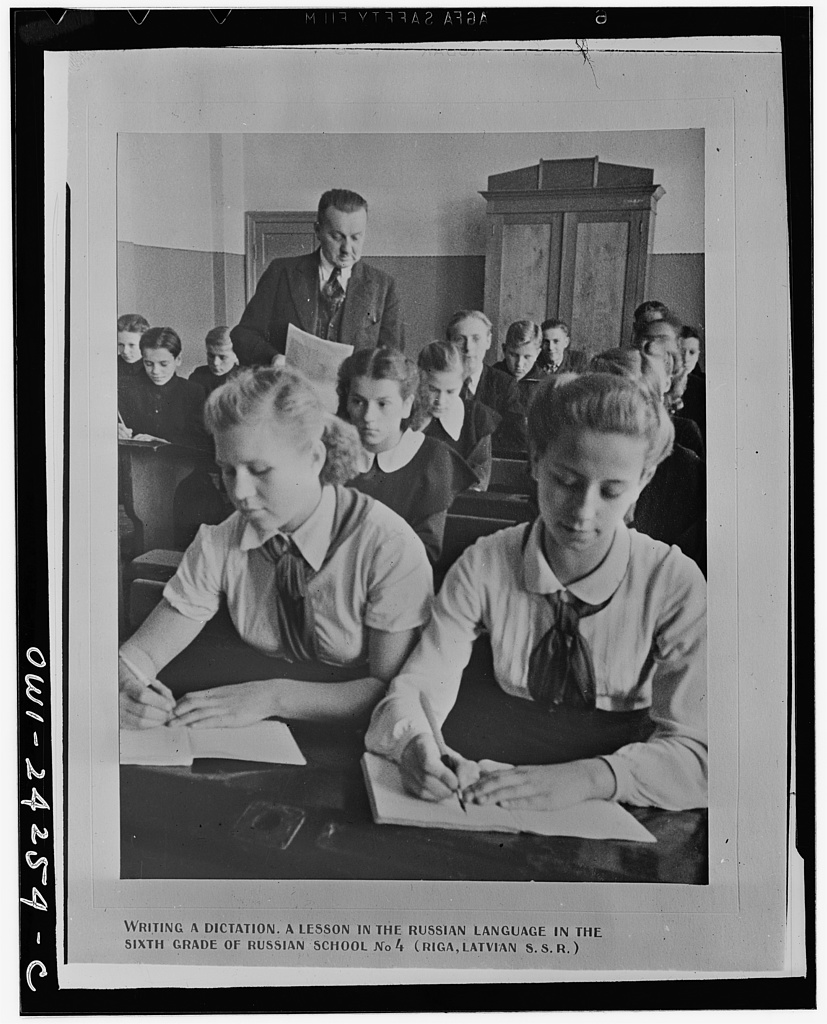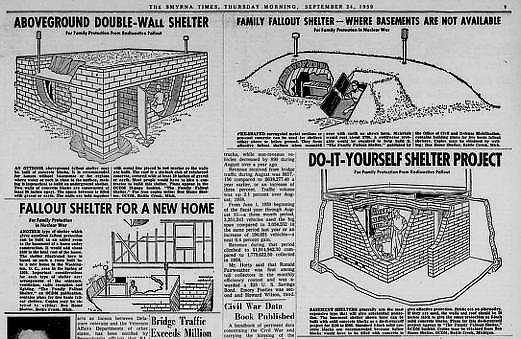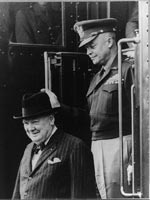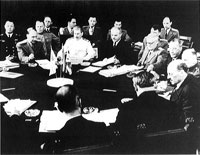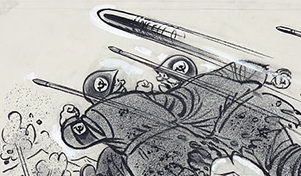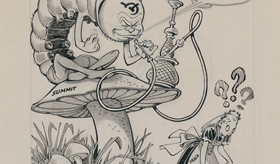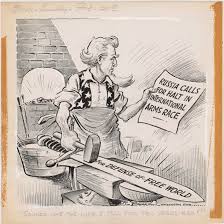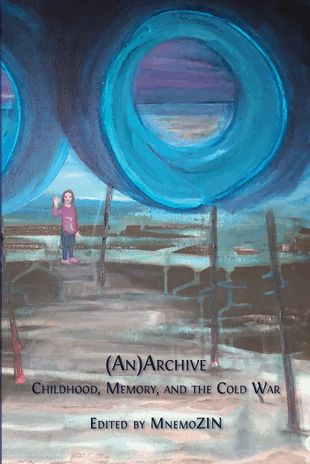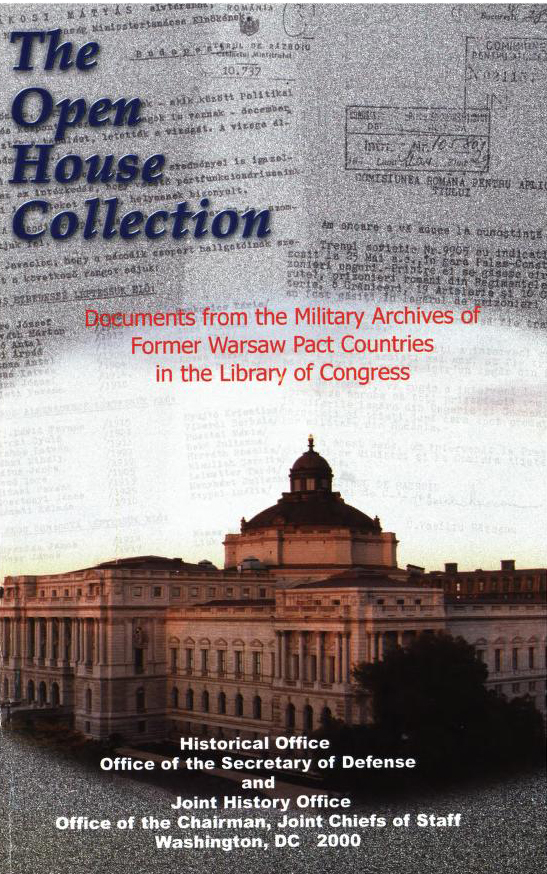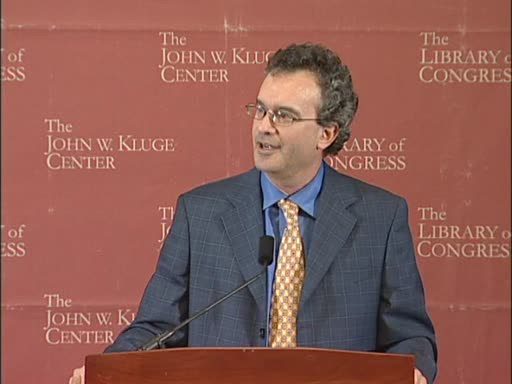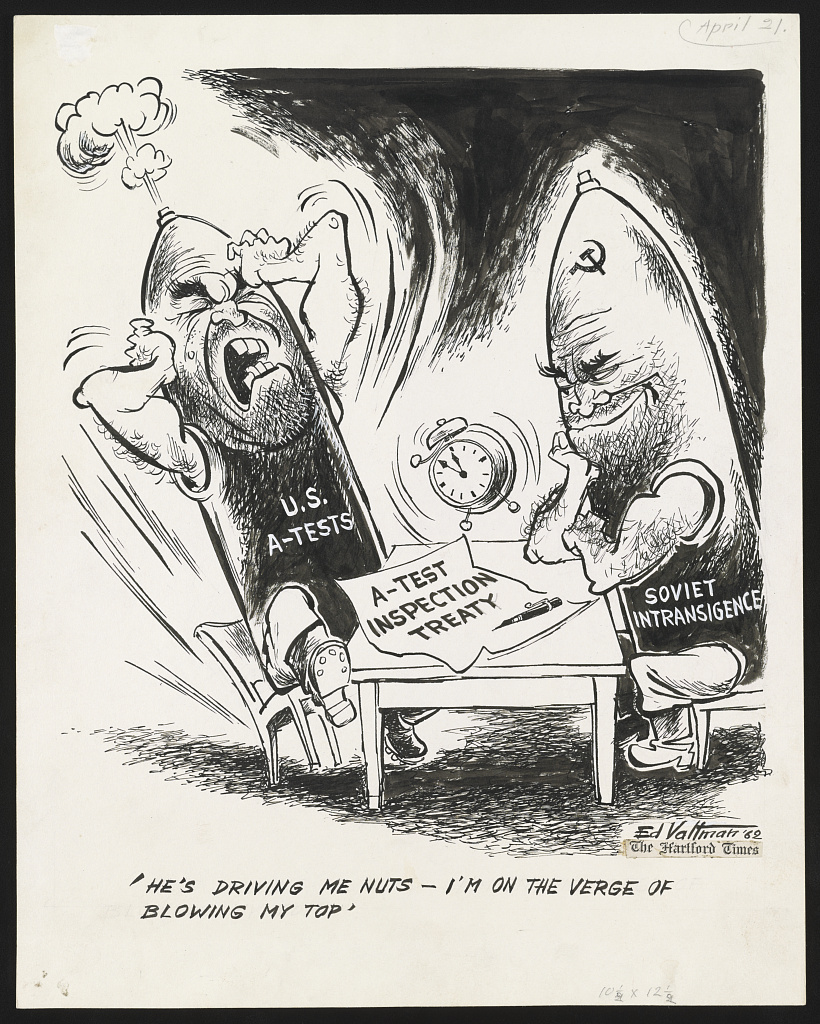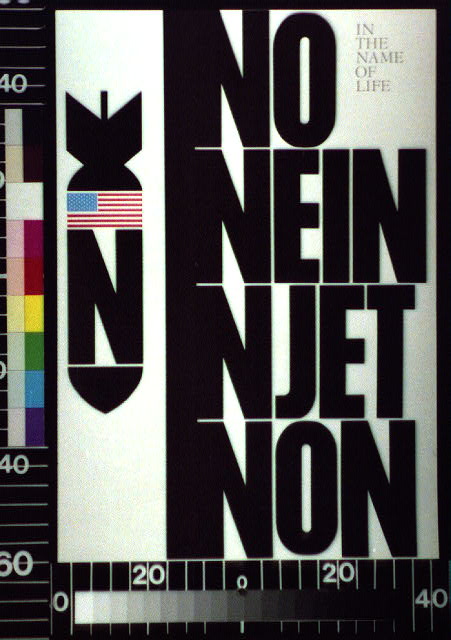This album was created by a member of the TPS Teachers Network, a professional social media network for educators, funded by a grant from the Library of Congress. For more information, visit tpsteachersnetwork.org.
Cold War Primary Sources & Teaching Resources
Album Description
The Cold War was an international contest between capitalist and communist countries that lasted from roughly 1947 to 1991. The United States exerted its power and influence over a number of countries, including much of Western Europe, while the Soviet Union dominated life in Eastern Europe. Globally, the Cold War shaped relationships between nations, with new international alliances and organizations emerging.
This album links to a variety of Cold War resources mainly from the Library of Congress, Library partner organizations, the TPS Consortium, and the TPS Teachers Network.
Cold War Primary Source Set with Teacher’s Guide
Teaching Notes
In the years after World War II, the rise of atomic weapons, along with competing political and economic ideologies from two global powers – the United States and the Soviet Union – set into motion an era of competition and mistrust known today as the Cold War.
This primary source set from the Library of Congress supports teachers and students in investigating that historical period using newspapers, political cartoons, congressional speeches, maps, films, and other primary sources from the time.
Reference link: https://www.loc.gov/classroom-materials/cold-war/
Strategies for Teaching with the Cold War Primary Source Set
Teaching Notes
In a four-part series of posts for the Teaching with the Library blog,  Colleen Smith
provides strategies for analyzing select sources from the Cold War Primary Source Set.
Colleen Smith
provides strategies for analyzing select sources from the Cold War Primary Source Set.
Cold War Multimedia Primary Source Discussion Set
Teaching Notes
PRIMARY SOURCES
The video and audio clips in this source set from the American Archives of Public Broadcasting in collaboration with the Library of Congress are drawn from documentary footage, propagandist films, news reports, and recorded interviews; collectively, they map some of the broad contours of the Cold War. These sources provide details about major Cold War events, highlight individuals who figure prominently in Cold War history, and attest to the international and transnational importance of this conflict. They trace the global position and power of the United States throughout the second half of the twentieth century.
TEACHING RESOURCES
Before engaging with this resource set, students should be familiar with the following:
- U.S. and Soviet involvement in World War II
- The establishment, composition, and ideology of the Union of Socialist Soviet Republics (USSR)
- The Vietnam War
Essential Question: What is the significance of the Cold War within U.S. history?
Supporting Discussion Questions:
-
How did the Cold War extend beyond the United States and the Soviet Union?
-
Which events do histories of the Cold War typically highlight? Why?
-
What is the legacy of the Cold War, for the United States and globally?
Reference link: https://americanarchive.org/primary_source_sets/cold-war
A Visual Guide to the Cold War
Teaching Notes
This digital resource was designed for middle and high school educators and students who wish to explore the Cold War through visual primary sources. The materials are intended to enrich classroom and extracurricular learning and illustrate both the American and Soviet perspectives on the Cold War. Ranging from the end of WWII to the fall of the Soviet Union, the materials encompass a wide range of photographs, cartoons, posters and movie clips. Use the menu bar to browse by decade, theme, or material type.
This resource was produced by the Center for Slavic, Eurasian and East European Studies at the University of North Carolina at Chapel Hill as part of a project sponsored in part by the Library of Congress Teaching with Primary Sources Eastern Region Program, coordinated by Waynesburg University.
Reference link: https://coldwar.unc.edu/
Cold War Propaganda
Teaching Notes
From this TPS Teachers Network album:
Political cartoons were a powerful tool of propaganda during the Cold War, reflecting the intense ideological struggle between the United States and the Soviet Union. These cartoons often used satire and symbolism to convey complex political messages, shaping public opinion and reinforcing national narratives. Through exaggerated depictions of leaders, events, and policies, they provided insight into the fears, hopes, and tensions of the era, making them invaluable primary sources for understanding the period's political climate.
In a history class, the cartoons collected in this album offer students a visual gateway into the mindset and propaganda tactics of the Cold War. Firstly, students can critically examine individual cartoons using Analyzing Political Cartoons Teacher's Guide. Secondly, by comparing, contrasting, and corroborating cartoons on the same event from both the US and the Soviet Union, students can gain a deeper understanding of each side's perspective. This approach enables students to understand how each side of the conflict employed visual rhetoric to sway public perception and highlight the ideological divide.
Reference link: https://tpsteachersnetwork.org/single-group/tps-pd-providers-institute-pdpi/cold-war
Reference note
Album Cover image: 'This hurts me more than it hurts you!'
Summary
- Cartoon shows Soviet leader Nikita Khrushchev as a dentist about to extract Cuban leader Fidel Castro's teeth, drawn as missiles. In 1962, the United States discovered that the Soviet Union was installing missiles in Cuba. During the ensuing "Cuban Missile Crisis," President John F. Kennedy (1917-1963) announced that he was placing a blockade around Cuba to prevent the delivery of any more weapons. Khrushchev threatened war if Russian ships were stopped but finally backed down and agreed to remove the missiles.
Created / Published
- 1962 Oct. 30.
Genre
- Editorial cartoons--American
- Drawings
Notes
- - Published in: The Hartford times.
- - Published in Valtman : the editorial cartoons of Edmund S. Valtman, 1961-1991. Baltimore, Md. : Esto, 1991, p. 17.
- - Exhibited in: Kennedy and Krushchev in Vienna, The Vienna History Museum, Vienna, Austria, 2005.
- - (DLC/PP-1999:142.005)
- - ljr / 020328.
- - Unprocessed in PR13 CN 1999:142.005
Repository
- Library of Congress Prints and Photographs Division Washington, D.C. 20540 USA http://hdl.loc.gov/loc.pnp/pp.print
Digital Id
- ppmsc 07978 //hdl.loc.gov/loc.pnp/ppmsc.07978
- cph 3c30423 //hdl.loc.gov/loc.pnp/cph.3c30423
Cultural Classroom Comparison
Teaching Notes
This album compares classrooms and schools from the USSR and the United States during the 1940s to show the similarities and differences of education (publicly accessible album).
From the TPS Teachers Network album
These images provide students with a perspective on the daily life of students in the Soviet Union during World War II.
The resources in this album are meant as a compare and contrast introduction activity. Students in the United States are very familiar with the design of classrooms and schools, as they spend the majority of their adolescences in these spaces. Can students identify similarities and differences of schools from separate countries?
This activity is for 7th Grade Middle School students in US History II 1865 to Present Day. The goal for this activity is for students to make observations and to understand differing perspectives.
Guiding Questions:
- How similar and different are classrooms and schools across the world?
- Are students in schools around the globe learning the same lessons?
- What do think the students at these schools were learning?
Reference link: https://tpsteachersnetwork.org/single-group/tps-pd-providers-institute-pdpi/the-cold-war
Reference note
Album Cover image: Sixth grade school room in the Latvian USSR (Union of Soviet Socialist Republics)
Created / Published
- between 1930 and 1940?
Genre
- Safety film negatives
Notes
- - Image source: National Council of American-Soviet Friendship, New York.
- - Title and other information from caption card.
- - Transfer; United States. Office of War Information. Overseas Picture Division. Washington Division; 1944.
- - More information about the FSA/OWI Collection is available at http://hdl.loc.gov/loc.pnp/pp.fsaowi
- - Temp. note: owibatch6
- - Film copy on SIS roll 0, frame 0.
Repository
- Library of Congress Prints and Photographs Division Washington, D.C. 20540 USA http://hdl.loc.gov/loc.pnp/pp.print
Digital Id
- fsa 8e01056 //hdl.loc.gov/loc.pnp/fsa.8e01056
Fallout Shelters
Teaching Notes
The reference link leads to the results of a search for fallout shelters in the Chronicling America historical newspaper collection from January 1, 1945 to December 31, 1963.
For more information on fallout shelters, check out, Doomsday in the Suburbs: When Fallout Shelters Took Over America, a post from Network Mentor  Peter Pappas
.
Peter Pappas
.
Cold War and Long Sunset: Churchill and the Great Republic
Teaching Notes
From the online exhibition
Though out of office in Britain, Churchill retained huge prestige and influence on the international stage. In March 1946, at the encouragement of President Harry Truman, he traveled to Westminster College in Fulton, Missouri, to speak. His speech was a call for closer Anglo-American cooperation in the post-war world, but it is now best remembered for its warnings about the threat of Soviet expansionism, eloquently captured in the phrase “Iron Curtain.”
Churchill continued to speak out on the great issues—the Cold War, the atomic bomb, and European unity—always stressing the importance of a "special relationship" between the British Empire and the United States. Then, in October 1951, the Conservative Party won the general election, and he returned as Prime Minister.
During his second premiership Churchill worked hard to strengthen Anglo-American relations, retain British global influence, and, above all, initiate a summit meeting with Stalin's successors in the Kremlin. He felt that strong negotiation might obtain an end to the nuclear arms race and establish détente in the Cold War. In this goal he was frustrated, partly by his own failing health, partly by the opposition of President Dwight Eisenhower and other Western leaders who favored a harder line against communism and the Soviet Union, and partly by the new Soviet leaders who resisted détente.
Reference link: https://www.loc.gov/exhibits/churchill/wc-coldwar.html
Reference note
Album Cover image: Churchill and Eisenhower
Cold War: Revelations from the Russian Archives
Teaching Notes
Exhibition sections
From the online exhibition
Relations between the Soviet Union and the United States were driven by a complex interplay of ideological, political, and economic factors, which led to shifts between cautious cooperation and often bitter superpower rivalry over the years. The distinct differences in the political systems of the two countries often prevented them from reaching a mutual understanding on key policy issues and even, as in the case of the Cuban missile crisis, brought them to the brink of war.
The Soviet Union and the United States stayed far apart following World War II during the decades of superpower conflict and the nuclear and missile arms race. Beginning in the early 1970s, the Soviet regime proclaimed a policy of détente and sought increased economic cooperation and disarmament negotiations with the West. However, the Soviet stance on human rights and its invasion of Afghanistan in 1979 created new tensions between the two countries. These tensions continued to exist until the dramatic democratic changes of 1989–91 led to the collapse during this past year of the Communist system and opened the way for an unprecedented new friendship between the United States and Russia, as well as the other new nations of the former Soviet Union.
Reference link: https://www.loc.gov/exhibits/archives/sovi.html
Reference note
Album Cover image: Stalin at Potsdam
Herblock! “White is Black, Black is White, Night is Day—”
Teaching Notes
From the online exhibition
In the years following World War II, growing tensions between world powers and the chilling threat of nuclear warfare gave rise to what is commonly called the “Cold War Era.” Between 1948 and 1953 these tendencies intensified. As the leading democracy in the postwar world, the United States found its influence and authority challenged by dictators of totalitarian states as they consolidated their positions in the global hierarchy. Herb Block’s cartoons during this time critique the nature of totalitarian states and their sometimes violent imposition of authority on their own societies and others. He also voiced the urgent need for international agreement on nuclear arms control. Block won his second Pulitzer Prize for his 1953 cartoon on the death of Joseph Stalin. As relations worsened between the U.S. and the Soviet Union, internal debates flared within the U.S. over varied forms of communist infiltration. Communist China took aggressive action in Korea, which eventually led to American involvement in the Korean War.
Reference link: https://www.loc.gov/exhibits/herblock/white-is-black-black-is-white-night-is-day.html
Reference note
Album Cover image: “You Know, That Cold War Wasn’t So Bad”
Cold War - Pointing Their Pens: Herblock and Fellow Cartoonists Confront the Issues
Teaching Notes
From the online exhibition
In the decades after World War II, mutual distrust between the United States and the Soviet Union led to international tension and the chilling threat of nuclear warfare in an era commonly called the “Cold War.” As early as 1946, six out of every ten Americans believed that the Soviet Union was more interested in world dominance than world peace. Despite a series of ongoing disarmament talks, cartoonists—like other Americans—did not find solace in either Joseph Stalin’s or Nikita Khrushchev’s terms for peace in the 1950s and 1960s. Few American editorial cartoonists favored the Soviet government during the Cold War, but they had divergent responses to the fear of nuclear warfare.
Also see ‘Tis the season to be jolly, my good man! We won—did you know that? Capitalism is triumphant. Communism lies in ruins. Our system prevails! We won! Smile! December 8, 1989 from Oliphant’s Anthem: War & Diplomacy online exhibition
Reference note
Album Cover image: "Alice Remains in Wonderland"
The Cold War in Political Cartoons, 1946 - 1963
Teaching Notes
In this lesson plan from NARA Center for Legislative Archives Educational Resources, students analyze political cartoons from the Cold War Era to learn about five important issues and to understand the relationship of the United States to the world in this era of fundamental changes in foreign policy.
In addition to this NARA Cartoon Analysis Worksheet, students could refer to the Library of Congress Analyzing Political Cartoons guide.
Reference link: https://www.archives.gov/legislative/resources/education/cold-war-in-political-cartoons
Reference note
The above political cartoon is titled "Sounds Like the Line I fell for Ten Years Ago" and is part of the Jim Berryman Political Cartoons, 1928–1963.
An Archive: Childhood, Memory, and the Cold War
Teaching Notes
From the source record
"What was it like growing up during the Cold War? What can childhood memories tell us about state socialism and its aftermath? How can these intimate memories complicate history and redefine possible futures?" These questions are at the heart of this book. This edited collection stems from a collaboration between academics and artists who came together to collectively remember their own experiences of growing up on both sides of the 'Iron Curtain'. Looking beyond official historical archives, the book gathers memories that have been erased or forgotten, delegitimized or essentialized, or, at best, reinterpreted nostalgically within the dominant frameworks of the East-West divide. And it reassembles and (re)stores these childhood memories in a form of an anarchive': a site for merging, mixing, connecting, but also juxtaposing personal experiences, public memory, political rhetoric, places, times, and artifacts.
Reference link: https://www.loc.gov/item/2021388883/
The Open House Collection: Documents from the Military Archives of Former Warsaw Pact Countries
Teaching Notes
On June 28 and 29, 2000, the Library and the Department of Defense, presented a conference called "Cold War Archives in the Decade of Openness," held at the Library of Congress. The conference was the result of a four-year effort, known as the "Open House Project," that brought microfilm of formerly classified records from the military archives of Hungary, Poland and Romania to the Library of Congress.
The conference explored the contents of the microfilm, the state of the Central European archives represented at the conference, and the activities of archives in the United States that focus exclusively on Cold War topics or have significant collections relating to the Cold War.
Reference link: https://www.loc.gov/item/00039959
Cold War Discussions at the Library of Congress
Teaching Notes
These videos come from Library event recordings related to the Cold War.
Cold War: Finding Images in the Prints & Photographs Division
Teaching Notes
From the Research Guide
The Library of Congress Prints & Photographs Division offers rich pictorial resources documenting Cold War events, its key players, and the clash of ideas it embodied. The images include photographs, cartoons, and posters. This guide points out collections particularly strong for documenting the geopolitics and ideological struggles of the era, with a special focus on pictures that are rights-free. In some cases, collections contain both rights-free and some potentially copyright restricted imagery. The guide includes search strategies for locating rights-free images in these circumstances.
Reference link: https://guides.loc.gov/cold-war-images
Reference note
Album Cover image: "He's driving me nuts - I'm on the verge of blowing my top"
Summary
- Editorial cartoon drawing shows two hairy, muscular, anthropomorphic atomic bombs labeled "U.S. A-Tests" and "Soviet Intransigence" sitting at a table on which is a ringing alarm clock and a paper waiting to be signed that is labeled "A-Test Inspection Treaty." The U.S. atomic bomb is about to blow his top waiting for the Soviet atomic bomb to sign the treaty; the Soviet Union refused to accept on-site inspections of its nuclear weapons program, which caused a delay in the signing of a nuclear test-ban treaty.
Created / Published
- [Hartford, Connecticut] : [Publisher not identified], April 21 [19]62.
Genre
- Editorial cartoons--1960-1970
- Drawings--1960-1970
Notes
- - Title from item.
- - Signed on lower right.
- - Published in The Hartford Times.
- - (DLC/PP-2001:055-4)
- - Forms part of: Art Wood Collection of Cartoon and Caricature (Library of Congress).
- - Exhibited: "Pointing Their Pens : Herblock and Fellow Cartoonists Confront the Issues" in the Graphics Art Gallery, Thomas Jefferson Building, Library of Congress, Washington, D.C., September 2015 - March 2016.
- - Unprocessed in WOOD/Valtman
Repository
- Library of Congress Prints and Photographs Division Washington, D.C. 20540 USA http://hdl.loc.gov/loc.pnp/pp.print
Digital Id
- ppmsca 38557 //hdl.loc.gov/loc.pnp/ppmsca.38557
Cold War Resources in the Manuscript Division
Teaching Notes
The holdings of the Library of CongressManuscript Division document many aspects of the Sold War struggle. They include the private papers of political, military, scientific, and cultural figures, and the records of influential organizations. This resource guide lists relevant collections, divided by appropriate subject areas to aid research. Links to selected external websites are included.
Reference link: https://guides.loc.gov/cold-war-mss/introduction
Reference note
Album Cover image: No, nein, njet, non : in the name of life
Created / Published
- [between 1965 and 1980]
Genre
- Posters--American--1960-1980
- Prints--Color--1960-1980
Notes
- - Title from item.
- - Gift: Gary Yanker; 1975-1983.
Repository
- Library of Congress Prints and Photographs Division Washington, D.C. 20540 USA http://hdl.loc.gov/loc.pnp/pp.print
Digital Id
- yan 1a38575 https://hdl.loc.gov/loc.pnp/yan.1a38575

